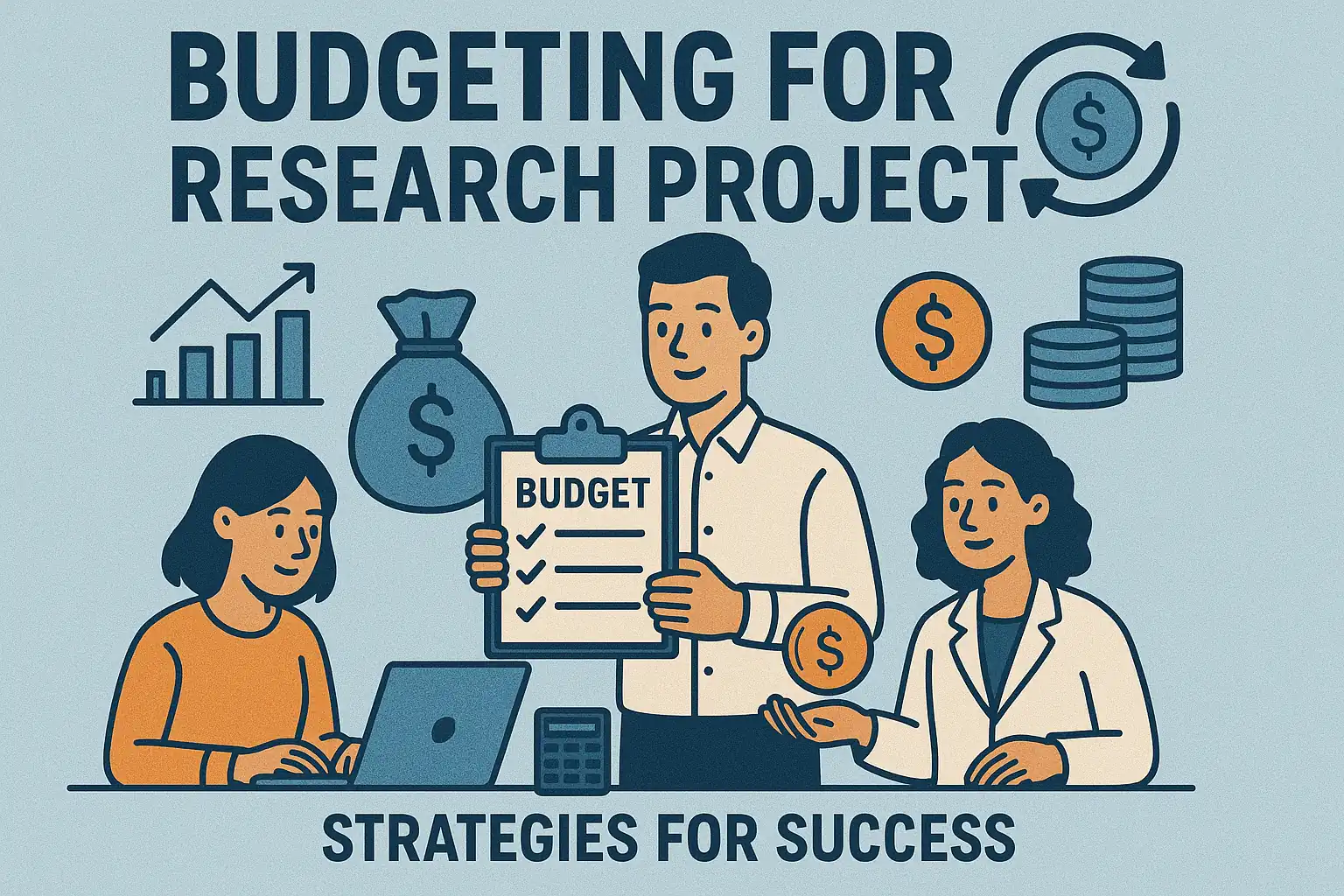Introduction to Budgeting in Research Projects
Budgeting is a critical component of project management, particularly in research projects. It serves as a financial roadmap that guides project managers and stakeholders through the complexities of resource allocation, cost control, and financial oversight. In the context of research projects, budgeting involves planning, estimating, allocating, and controlling the financial resources necessary to achieve specific research objectives. This process is essential not only for ensuring that projects remain financially viable but also for maximizing the return on investment in research activities.
Unique Challenges of Budgeting for Research Projects
Research projects often present unique budgeting challenges that differentiate them from other types of projects. Some of these challenges include:
- Unpredictable Costs: Research can be inherently uncertain, with unforeseen expenses arising from experimental failures, changes in project scope, or the need for additional resources. This unpredictability makes it difficult to create accurate budget estimates and requires continuous monitoring and adjustment of financial plans [10][11].
- Complex Funding Sources: Research projects frequently rely on multiple funding sources, including grants, institutional funds, and private investments. Each source may have different requirements and restrictions, complicating the budgeting process and necessitating careful management to ensure compliance with funding conditions [12][14].
- Scope Creep: As research progresses, the scope of the project may expand due to new findings or opportunities. This phenomenon, known as scope creep, can strain budgets and lead to financial mismanagement if not carefully monitored and controlled [15].
The Role of the Research Project Manager in Financial Management
The research project manager plays a pivotal role in the financial management of research projects. Their responsibilities include:
- Budget Development: Project managers are tasked with creating detailed budgets that accurately reflect the costs associated with various project activities. This involves estimating expenses based on historical data and current project needs, as well as aligning the budget with the overall research objectives [9][14].
- Financial Oversight: Effective budget management requires ongoing financial oversight. Research project managers must conduct regular financial reviews to identify potential issues early, allowing for timely adjustments to the budget and project plans. This proactive approach helps maintain the project’s financial health and ensures that resources are allocated efficiently [2][7].
- Communication and Collaboration: Clear communication about financial goals and budget limits is essential for successful budgeting in research projects. Project managers must engage with team members, stakeholders, and financial officers to ensure everyone understands the financial framework and their roles in adhering to it Understanding the Components of a Research Project Budget
Understanding the Components of a Research Project Budget
Creating a comprehensive budget for a research project is crucial for ensuring its success and sustainability. Research project managers and financial officers must be adept at identifying and managing various budget components. Here are the key elements that constitute a well-structured research project budget:
Direct Costs: These are expenses that can be directly attributed to the research project. They typically include:
- Salaries: Compensation for researchers, assistants, and other personnel directly involved in the project.
- Materials: Costs for consumables and supplies necessary for conducting research.
- Equipment: Expenses related to purchasing or leasing equipment essential for the project’s execution. Properly estimating these costs is vital, as they can significantly impact the overall budget [6][14].
Indirect Costs: Also known as overhead costs, these are expenses that are not directly tied to a specific project but are necessary for the overall operation of the research institution. They include:
- Administrative Expenses: Costs associated with the general administration of the research facility, such as utilities, office supplies, and support staff salaries.
- Overhead: This may cover facilities maintenance, institutional support, and other shared resources that contribute to the research environment. Understanding how these costs are calculated and allocated is essential for accurate budgeting [13][14].
- Contingency Funds: It is important to allocate a portion of the budget for unforeseen expenses. Contingency funds act as a financial buffer to address unexpected challenges or changes in project scope. This practice helps mitigate risks and ensures that the project can continue smoothly even when surprises arise [9][10].
Funding Sources: Identifying and including potential funding sources in the budget is critical. This includes:
- Grants: Funds received from government agencies, foundations, or other organizations specifically for research purposes.
- Institutional Support: Financial backing from the research institution itself.
- Private Sector Contributions: Sponsorships or partnerships with industry stakeholders. Understanding the implications of each funding source, such as reporting requirements and restrictions, is vital for effective financial management [4][5][15].
By thoroughly understanding these components, research project managers can create a robust budget that not only supports the project’s objectives but also aligns with the financial policies of their institutions. This strategic approach to budgeting is essential for the successful management of research projects and can significantly enhance their chances of success.
Best Practices for Creating a Research Budget
Creating a robust budget is essential for the success of any research project. Research project managers and financial officers can implement several best practices to ensure effective budgeting and financial management. Here are key strategies to consider:
- Conduct Thorough Needs Assessments: Before developing a budget, it is crucial to perform a comprehensive needs assessment. This involves identifying all necessary resources, including personnel, equipment, supplies, and any indirect costs associated with the project. A detailed understanding of what is required will help in creating a more accurate budget that reflects the true needs of the project [3][10].
- Engage Stakeholders in the Budgeting Process: Involving stakeholders—such as team members, funding bodies, and institutional administrators—early in the budgeting process can foster collaboration and buy-in. Their insights can provide valuable perspectives on resource allocation and potential challenges, leading to a more comprehensive and accepted budget [5][10].
- Utilize Historical Data and Benchmarks: Leveraging historical data from previous projects can significantly enhance the accuracy of cost estimations. By analyzing past budgets and outcomes, project managers can identify trends and benchmarks that inform realistic financial projections. This practice not only aids in cost estimation but also helps in justifying budget requests to stakeholders [11][12].
- Incorporate Flexibility to Accommodate Changes: Research projects often encounter unforeseen circumstances that may necessitate adjustments to the budget. Therefore, it is essential to build flexibility into the budget. This can be achieved by including contingency reserves and regularly reviewing and updating the budget as the project progresses. Such adaptability ensures that the project can respond effectively to changes in scope or unexpected expenses [9][10][12].
By implementing these best practices, research project managers can create budgets that not only meet the financial requirements of their projects but also enhance overall project management and stakeholder confidence.
Monitoring and Controlling the Budget
Effective budgeting and financial management are crucial for the success of research projects. Continuous monitoring and control of the budget not only help in maintaining financial health but also ensure that project objectives are met without overspending. Here are some best practices for research project managers and financial officers to consider:
- Set Up Regular Budget Reviews and Updates: Establishing a routine for budget reviews is essential. Regularly scheduled reviews allow project managers to assess the current financial status against the planned budget. This practice helps in identifying any discrepancies early on, enabling timely corrective actions. Frequent financial reviews can also facilitate informed decision-making, ensuring that the project remains on track financially [6][11].
- Implement Financial Tracking Tools and Software: Utilizing financial tracking tools and software can significantly enhance budget management. These tools provide real-time data on expenditures, helping project managers to monitor spending against the budget effectively. By automating financial tracking, project managers can reduce manual errors and save time, allowing them to focus on strategic decision-making [5][9].
- Establish Key Performance Indicators (KPIs) for Financial Performance: Defining KPIs related to financial performance is vital for measuring the success of budget management efforts. KPIs can include metrics such as cost variance, budget adherence, and return on investment. By regularly evaluating these indicators, project managers can gain insights into financial performance and make data-driven adjustments to the budget as needed [10][14].
- Discuss How to Handle Budget Variances and Make Necessary Adjustments: Budget variances are common in research projects, and having a clear strategy for addressing them is essential. When variances occur, project managers should analyze the reasons behind them—whether they are due to unforeseen expenses, changes in project scope, or other factors. Based on this analysis, adjustments can be made to the budget or project plan to realign with financial goals. Open communication with stakeholders about these adjustments is crucial to maintain trust and transparency [6][12][15].
By implementing these strategies, research project managers can enhance their ability to monitor and control budgets effectively, ultimately leading to more successful project outcomes.
Reporting and Communicating Budget Status
Effective communication regarding budget status is crucial for research project managers and financial officers. It ensures that all stakeholders are informed and aligned with the financial aspects of the project. Here are some best practices for reporting and communicating budget status effectively:
Key Information to Include in Budget Reports
- Budget Overview: Start with a summary of the overall budget, including total allocated funds, expenditures to date, and remaining balance. This provides a snapshot of the project’s financial health.
- Detailed Expenditure Breakdown: Include a detailed account of expenditures categorized by line items (e.g., personnel, materials, travel). This helps stakeholders understand where funds are being utilized and identify any areas of concern [6].
- Variance Analysis: Highlight any variances between the budgeted amounts and actual expenditures. Explain the reasons for these variances, whether they are due to unforeseen expenses or savings, to provide context [11].
- Forecasting: Offer projections for future spending based on current trends. This can help stakeholders anticipate funding needs and make informed decisions moving forward [11].
- Impact Assessment: Discuss the impact of the budget on project outcomes. This includes how financial decisions affect project timelines, deliverables, and overall success [7].
Importance of Transparency in Financial Reporting
Transparency in financial reporting fosters trust and accountability among stakeholders. It allows for:
- Informed Decision-Making: When stakeholders have access to clear and accurate financial information, they can make better decisions regarding resource allocation and project adjustments [13].
- Enhanced Collaboration: Open communication about budget status encourages collaboration among team members and stakeholders, leading to more effective problem-solving and project management [12].
- Risk Management: By being transparent about financial challenges, project managers can proactively address potential risks and engage stakeholders in finding solutions [15].
Tips for Presenting Budget Information to Non-Financial Stakeholders
- Use Clear and Simple Language: Avoid jargon and technical terms that may confuse non-financial stakeholders. Instead, use straightforward language to explain financial concepts [13].
- Visual Aids: Incorporate charts, graphs, and infographics to present budget data visually. This can make complex information more digestible and engaging for the audience [8].
- Focus on Key Takeaways: Highlight the most critical points in your presentation. Summarize the budget status, key variances, and implications for the project in a concise manner [12].
- Encourage Questions: Create an open environment where stakeholders feel comfortable asking questions. This not only clarifies any uncertainties but also fosters a collaborative atmosphere [14].
- Regular Updates: Schedule regular budget status updates to keep stakeholders informed. Consistent communication helps maintain engagement and ensures that everyone is on the same page regarding financial matters [15].
By implementing these strategies, research project managers can enhance their reporting and communication practices, ultimately leading to more successful project outcomes and stronger stakeholder relationships.
Case Studies: Successful Budgeting in Research Projects
Effective budgeting is crucial for the success of research projects, as it not only ensures that resources are allocated efficiently but also enhances stakeholder confidence and project outcomes. Below are two case studies that exemplify successful budgeting practices in research projects, highlighting the strategies employed and the lessons learned.
Case Study 1: Multidisciplinary Research Initiative
Overview: A large-scale research initiative aimed at studying the effects of climate change on biodiversity involved a multidisciplinary team of scientists from various fields. The project required meticulous budgeting to manage personnel costs, direct research expenses, and indirect costs effectively.
Strategies Employed:
- Detailed Budget Planning: The project manager developed a comprehensive budget that categorized expenses into personnel costs, direct research costs, and overheads. This breakdown allowed for better tracking and management of funds throughout the project lifecycle [9].
- Regular Budget Reviews: The budget was reviewed and revised periodically, ensuring that any changes in project scope or unexpected expenses were accounted for. This adaptive approach helped maintain financial control and accountability [9].
- Stakeholder Engagement: Regular updates were provided to stakeholders regarding budget status and spending, fostering transparency and trust [12].
Lessons Learned:
- Flexibility is Key: The ability to adapt the budget in response to changing project needs was vital for maintaining project momentum and achieving objectives.
- Collaboration Enhances Accuracy: Involving team members from different disciplines in the budgeting process led to more accurate estimations and a better understanding of resource needs.
Case Study 2: Educational Research Program
Overview: An educational research program focused on developing innovative teaching methods for underprivileged schools faced challenges in managing its budget due to fluctuating funding sources and varying project deliverables.
Strategies Employed:
- Zero-Based Budgeting (ZBB): The project manager implemented a zero-based budgeting approach, where every expense had to be justified for each new period. This method ensured that funds were allocated based on current project needs rather than historical spending patterns [14].
- Cost Control Measures: The team established strict cost control measures to prevent overspending, including regular financial audits and performance reviews [12].
– Participative Budgeting: Engaging team members in the budgeting process helped identify potential cost-saving measures and fostered a sense of ownership over the project’s financial management [2].
Lessons Learned:
- Justification of Expenses: ZBB encouraged a culture of accountability, where every team member understood the importance of justifying their budget requests.
- Team Involvement is Crucial: Involving team members in the budgeting process not only improved financial management but also enhanced team morale and commitment to project goals.
Conclusion: The Path to Successful Research Project Budgeting
Effective budgeting is not merely a task but a critical component that can determine the success or failure of a project. As we have explored, several essential components and best practices are vital for creating a robust budget that aligns with project objectives and ensures financial health.
Key Components and Best Practices Recap:
- Thorough Planning: A well-structured budget begins with comprehensive planning that breaks down the project into distinct activity categories, including personnel costs, direct research costs, and indirect expenses. This clarity helps in aligning the budget with project goals and stakeholder expectations [3][4].
- Regular Reviews: Frequent financial reviews are crucial for identifying potential economic issues early. This proactive approach allows project managers to adjust plans as necessary, ensuring that the project remains on track financially [10].
- Education and Adaptation: The landscape of research funding and financial management is ever-evolving. Continuous education on budgeting strategies and adapting to new financial practices is essential for project managers and financial officers to stay ahead [5][14].
- Collaboration and Communication: Open and clear communication about financial goals and budget limits among all team members fosters a collaborative environment that enhances financial management [13].
As we conclude, it is imperative for research project managers and financial officers to recognize the importance of these budgeting strategies. By implementing the best practices discussed, they can significantly improve financial management in their research projects, leading to better outcomes and increased stakeholder confidence.
Find out more about Shaun Stoltz https://www.shaunstoltz.com/about/.
This post was written by an AI and reviewed/edited by a human.



